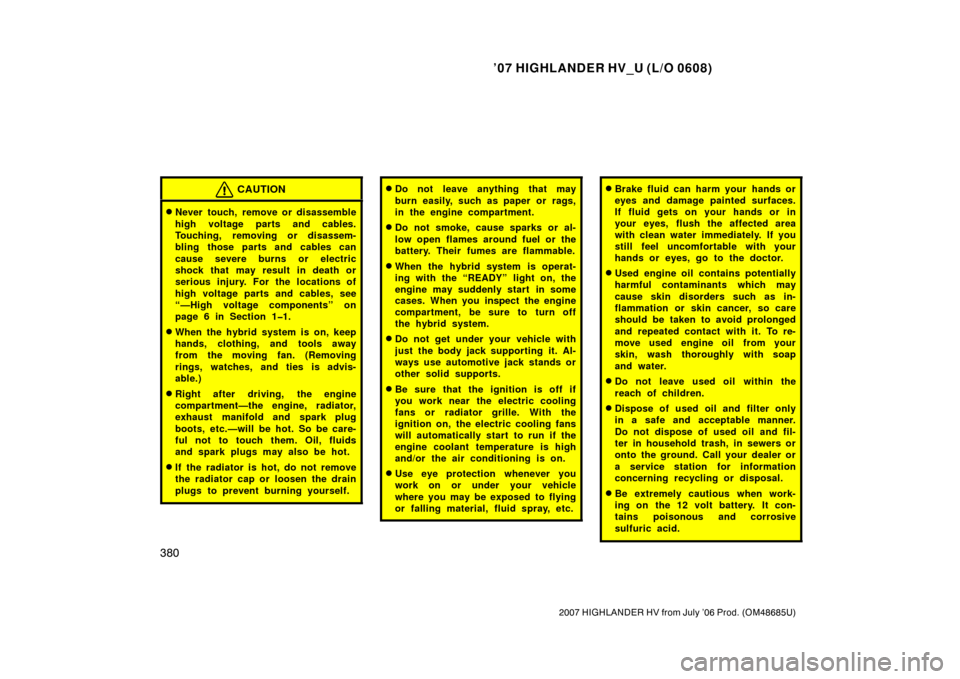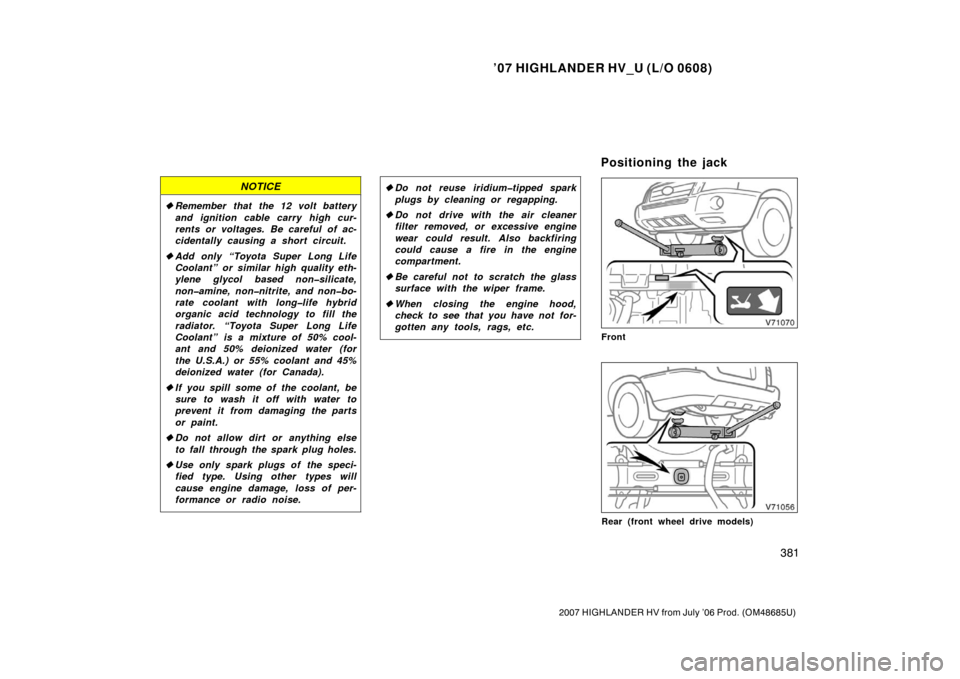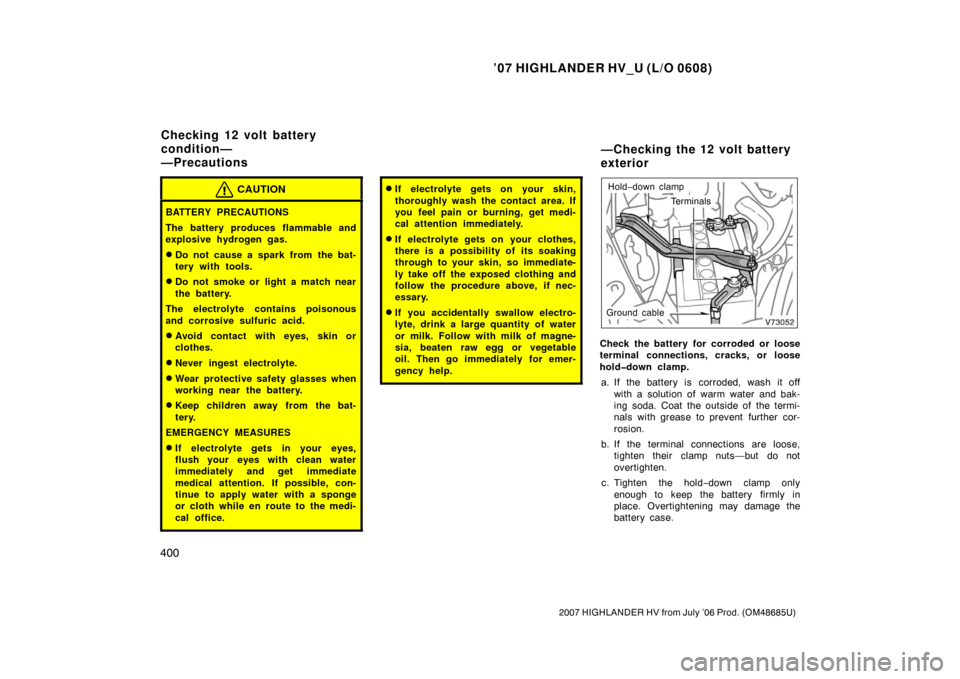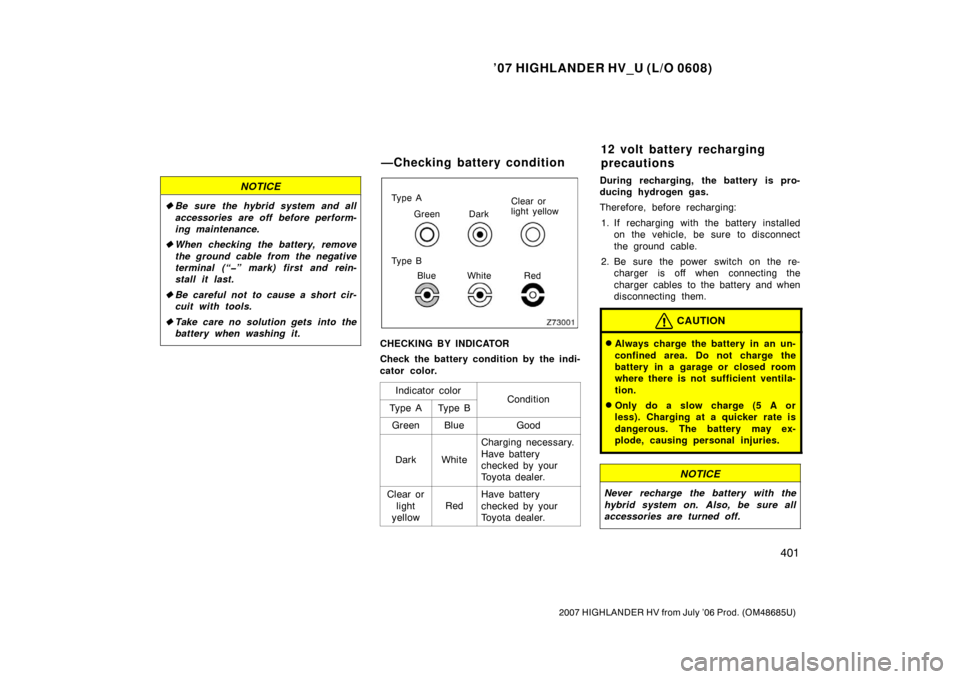Page 386 of 436

’07 HIGHLANDER HV_U (L/O 0608)
374
2007 HIGHLANDER HV from July ’06 Prod. (OM48685U)
Some states have vehicle emission in-
spection programs which include OBD
(On−Board Diagnostics) che cks.
The OBD system monitors the operation
of the emission control system. When the
OBD system determines that a problem
exists somewhere in the emission control
system, the malfunction indicator lamp
comes on. In this case, your vehicle may
not pass the I/M test and need to be
repaired. Contact your Toyota dealer to
service the vehicle.
Even if the malfunction indicator lamp
does not come on, your vehicle may not
pass the I/M test as readiness codes
have not been set in the OBD system.
Readiness codes are automatically set
during ordinary driving. However, when the
12 volt battery is disconnected or run
down, the codes are erased. Also, de-
pending on your driving habits, the codes
may not be completely set.
Also, if the malfunction indicator lamp had
come on recently due to temporary mal-
function such as a loose fuel tank cap,
your vehicle may not pass the I/M test. The malfunction indicator lamp will go off
after taking several driving trips, but the
error code in the OBD system will not be
cleared unless about 40 trips or more are
taken.
If your vehicle does not pass the I/M test
even the malfunction indicator lamp does
not come on, contact your Toyota dealer
to prepare the vehicle for re
−testing.
Emissions Inspection and
Maintenance (I/M) programs
Page 388 of 436
’07 HIGHLANDER HV_U (L/O 0608)
376
2007 HIGHLANDER HV from July ’06 Prod. (OM48685U)
1. Windshield and rear window washerfluid tank
2. Brake fluid reservoir
3. Engine oil level dipstick
4. Engine coolant reservoir
5. Engine oil filler cap
6. Inverter coolant reservoir
7. Fuse blocks
8. Engine coolant radiator
9. Condenser
10. Inverter coolant radiator
11. Electric cooling fans
12. 12 volt battery
Engine compartment overview
Page 392 of 436

’07 HIGHLANDER HV_U (L/O 0608)
380
2007 HIGHLANDER HV from July ’06 Prod. (OM48685U)
CAUTION
�Never touch, remove or disassemble
high voltage parts and cables.
Touching, removing or disassem-
bling those parts and cables can
cause severe burns or electric
shock that may result in death or
serious injury. For the locations of
high voltage parts and cables, see
“—High voltage components” on
page 6 in Section 1�1.
�When the hybrid system is on, keep
hands, clothing, and tools away
from the moving fan. (Removing
rings, watches, and ties is advis-
able.)
�Right after driving, the engine
compartment—the engine, radiator,
exhaust manifold and spark plug
boots, etc.—will be hot. So be care-
ful not to touch them. Oil, fluids
and spark plugs may also be hot.
�If the radiator is hot, do not remove
the radiator cap or loosen the drain
plugs to prevent burning yourself.
�Do not leave anything that may
burn easily, such as paper or rags,
in the engine compartment.
�Do not smoke, cause sparks or al-
low open flames around fuel or the
battery. Their fumes are flammable.
�When the hybrid system is operat-
ing with the “READY” light on, the
engine may suddenly start in some
cases. When you inspect the engine
compartment, be sure to turn off
the hybrid system.
�Do not get under your vehicle with
just the body jack supporting it. Al-
ways use automotive jack stands or
other solid supports.
�Be sure that the ignition is off if
you work near the electric cooling
fans or radiator grille. With the
ignition on, the electric cooling fans
will automatically start to run if the
engine coolant temperature is high
and/or the air conditioning is on.
�Use eye protection whenever you
work on or under your vehicle
where you may be exposed to flying
or falling material, fluid spray, etc.
�Brake fluid can harm your hands or
eyes and damage painted surfaces.
If fluid gets on your hands or in
your eyes, flush the affected area
with clean water immediately. If you
still feel uncomfortable with your
hands or eyes, go to the doctor.
�Used engine oil contains potentially
harmful contaminants which may
cause skin disorders such as in-
flammation or skin cancer, so care
should be taken to avoid prolonged
and repeated contact with it. To re-
move used engine oil from your
skin, wash thoroughly with soap
and water.
�Do not leave used oil within the
reach of children.
�Dispose of used oil and filter only
in a safe and acceptable manner.
Do not dispose of used oil and fil-
ter in household trash, in sewers or
onto the ground. Call your dealer or
a service station for information
concerning recycling or disposal.
�Be extremely cautious when work-
ing on the 12 volt battery. It con-
tains poisonous and corrosive
sulfuric acid.
Page 393 of 436

’07 HIGHLANDER HV_U (L/O 0608)
381
2007 HIGHLANDER HV from July ’06 Prod. (OM48685U)
NOTICE
�Remember that the 12 volt battery
and ignition cable carry high cur-
rents or voltages. Be careful of ac-
cidentally causing a short circuit.
� Add only “Toyota Super Long Life
Coolant” or similar high quality eth-
ylene glycol based non�silicate,
non�amine, non�nitrite, and non�bo-
rate coolant with long�life hybrid
organic acid technology to fill the
radiator. “Toyota Super Long Life
Coolant” is a mixture of 50% cool-
ant and 50% deionized water (for
the U.S.A.) or 55% coolant and 45%
deionized water (for Canada).
� If you spill some of the coolant, be
sure to wash it off with water to
prevent it from damaging the parts
or paint.
� Do not allow dirt or anything else
to fall through the spark plug holes.
� Use only spark plugs of the speci-
fied type. Using other types will
cause engine damage, loss of per-
formance or radio noise.
�Do not reuse iridium�tipped spark
plugs by cleaning or regapping.
� Do not drive with the air cleaner
filter removed, or excessive engine
wear could result. Also backfiring
could cause a fire in the engine
compartment.
� Be careful not to scratch the glass
surface with the wiper frame.
� When closing the engine hood,
check to see that you have not for-
gotten any tools, rags, etc.
Front
Rear (front wheel drive models)
Positioning the jack
Page 395 of 436
’07 HIGHLANDER HV_U (L/O 0608)
383
2007 HIGHLANDER HV from July ’06 Prod. (OM48685U)
Tools:
�Funnel (only for adding coolant)
CHECKING BRAKE FLUID
Parts (if level is low):
�SAE J1703 or FMVSS No.116 DOT 3
brake fluid
Tools:
�Rag or paper towel
�Funnel (only for adding fluid)
CHECKING 12 VOLT BATTERY
CONDITION
Tools:
�Warm water
�Baking soda
�Grease
�Conventional wrench
(for terminal clamp bolts)
CHECKING AND REPLACING FUSES
Parts (if replacement is necessary):
�Fuse with same amperage rating as
original ADDING WASHER FLUID
Parts:
�Water
�Washer fluid containing antifreeze
(for winter use)
Tools:
�Funnel
REPLACING LIGHT BULBS
Parts:
�Bulb with same number and wattage
rating as original (See charts in
“Replacing light bulbs” on page 404 in
Section 7 −3.)
Tools:
�Screwdriver
Page 411 of 436
’07 HIGHLANDER HV_U (L/O 0608)
399
2007 HIGHLANDER HV from July ’06 Prod. (OM48685U)
DO�IT�YOURSELF MAINTENANCE
Electrical components
Checking 12 volt battery condition400
. . . . . . . . . . . . . . . . . . . . . . . . . . . .
12 volt battery recharging precautions 401
. . . . . . . . . . . . . . . . . . . . . . . .
Checking and replacing fuses 402
. . . . . . . . . . . . . . . . . . . . . . . . . . . . . . . .
Adding washer fluid 403
. . . . . . . . . . . . . . . . . . . . . . . . . . . . . . . . . . . . \
. . . . .
Replacing light bulbs 404
. . . . . . . . . . . . . . . . . . . . . . . . . . . . . . . . . . . . \
. . . .
SECTION 7� 3
Page 412 of 436

’07 HIGHLANDER HV_U (L/O 0608)
400
2007 HIGHLANDER HV from July ’06 Prod. (OM48685U)
CAUTION
BATTERY PRECAUTIONS
The battery produces flammable and
explosive hydrogen gas.
�Do not cause a spark from the bat-
tery with tools.
�Do not smoke or light a match near
the battery.
The electrolyte contains poisonous
and corrosive sulfuric acid.
�Avoid contact with eyes, skin or
clothes.
�Never ingest electrolyte.
�Wear protective safety glasses when
working near the battery.
�Keep children away from the bat-
tery.
EMERGENCY MEASURES
�If electrolyte gets in your eyes,
flush your eyes with clean water
immediately and get immediate
medical attention. If possible, con-
tinue to apply water with a sponge
or cloth while en route to the medi-
cal office.
�If electrolyte gets on your skin,
thoroughly wash the contact area. If
you feel pain or burning, get medi-
cal attention immediately.
�If electrolyte gets on your clothes,
there is a possibility of its soaking
through to your skin, so immediate-
ly take off the exposed clothing and
follow the procedure above, if nec-
essary.
�If you accidentally swallow electro-
lyte, drink a large quantity of water
or milk. Follow with milk of magne-
sia, beaten raw egg or vegetable
oil. Then go immediately for emer-
gency help.
Hold −down clamp
Ground cable Terminals
Check the battery for corroded or loose
terminal connections, cracks, or loose
hold�down clamp.
a. If the battery is corroded, wash it off with a solution of warm water and bak-
ing soda. Coat the outside of the termi-
nals with grease to prevent further cor-
rosion.
b. If the terminal connections are loose, tighten their clamp nuts—but do not
overtighten.
c. Tighten the hold −down clamp only
enough to keep the battery firmly in
place. Overtightening may damage the
battery case.
Checking 12 volt battery
condition—
—Precautions —Checking the 12 volt battery
exterior
Page 413 of 436

’07 HIGHLANDER HV_U (L/O 0608)
401
2007 HIGHLANDER HV from July ’06 Prod. (OM48685U)
NOTICE
�Be sure the hybrid system and all
accessories are off before perform-
ing maintenance.
� When checking the battery, remove
the ground cable from the negative
terminal (“�” mark) first and rein-
stall it last.
� Be careful not to cause a short cir-
cuit with tools.
� Take care no solution gets into the
battery when washing it.Ty p e A
Green Dark Clear or
light yellow
Ty p e B Blue White Red
CHECKING BY INDICATOR
Check the battery condition by the indi-
cator color.
Indicator color
ConditionTy p e ATy p e B
GreenBlueGood
DarkWhite
Charging necessary.
Have battery
checked by your
Toyota dealer.
Clear orlight
yellow
Red
Have battery
checked by your
Toyota dealer.
During recharging, the battery is pro-
ducing hydrogen gas.
Therefore, before recharging:
1. If recharging with the battery installed on the vehicle, be sure to disconnect
the ground cable.
2. Be sure the power switch on the re- charger is off when connecting the
charger cables to the battery and when
disconnecting them.
CAUTION
�Always charge the battery in an un-
confined area. Do not charge the
battery in a garage or closed room
where there is not sufficient ventila-
tion.
�Only do a slow charge (5 A or
less). Charging at a quicker rate is
dangerous. The battery may ex-
plode, causing personal injuries.
NOTICE
Never recharge the battery with the
hybrid system on. Also, be sure all
accessories are turned off.
—Checking battery c ondition12 volt battery recharging
precautions